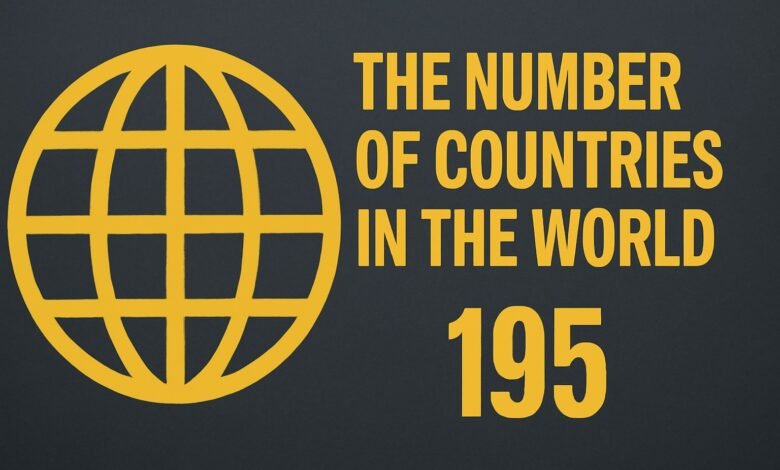Understanding the Number of Countries in the World: A Comprehensive Guide

Introduction to the Number of Countries
The total number of recognized countries in the world is a topic often accompanied by varying definitions and interpretations. As of April 2025, the commonly accepted figure stands at 195 countries, which includes 193 member states of the United Nations and 2 observer states, namely the Holy See and the State of Palestine. However, this count is not universally agreed upon due to the complicated nature of political recognition and the distinction between sovereign states and dependencies.
A sovereign state is typically defined as a political entity with a defined territory, a permanent population, a government, and the capacity to enter into relations with other states. In contrast, dependencies or territories often lack full independence and are usually governed or overseen by another country. Examples of dependencies include territories like Puerto Rico, which is overseen by the United States, and Bermuda, which is a British Overseas Territory. These nuances complicate the global map of countries, as the political status of these regions can vary widely and affect their recognition in international matters.
The political recognition of a country plays a crucial role in its status within the global community. Some regions declare independence but are not universally recognized, leading to debates about their status. For instance, Taiwan operates as an independent nation but is only officially recognized by a limited number of countries due to complex geopolitical circumstances. As a result, the number of countries is influenced by diplomatic relations, international law, and recognition by global bodies like the United Nations. Therefore, understanding the number of countries in the world involves not just a headcount but also an appreciation of the underlying political frameworks that define nationhood.
List of Countries and Their Currencies
The world today is comprised of numerous countries, each with its own unique identity, culture, and currency. Understanding these currencies is essential for international trade, travel, and economic collaboration. Below, we categorize countries by continent, along with their respective currencies to serve as a straightforward reference for individuals interested in global currencies.
Africa
Africa consists of 54 recognized countries, with currencies ranging widely. Notable examples include:
- Nigeria – Nigerian Naira (NGN)
- South Africa – South African Rand (ZAR)
- Kenyai – Kenyan Shilling (KES)
- Egypt – Egyptian Pound (EGP)
Asia
Asia, the largest continent, is home to 49 countries and a diverse array of currencies. Some prominent currencies include:
- China – Renminbi (CNY)
- Pakistan – Pakistani Rupee (PKR)
- Bangladesh – Bangladeshi Taka (TK)
- India – Indian Rupee (INR)
- Japan – Japanese Yen (JPY)
- South Korea – South Korean Won (KRW)
Europe
Europe has 44 recognized countries, many of which have adopted the Euro (EUR). However, several countries maintain their currencies:
- Germany – Euro (EUR)
- United Kingdom – British Pound (GBP)
- Switzerland – Swiss Franc (CHF)
- Norway – Norwegian Krone (NOK)
North America
North America comprises 23 countries, with the following notable currencies:
- United States – United States Dollar (USD)
- Canada – Canadian Dollar (CAD)
- Mexico – Mexican Peso (MXN)
Oceania
Oceania includes 14 countries, with currencies that reflect both local cultures and international ties:
- Australia – Australian Dollar (AUD)
- New Zealand – New Zealand Dollar (NZD)
- Fiji – Fijian Dollar (FJD)
South America
South America consists of 12 countries, showcasing a variety of currencies as well:
- Brazil – Brazilian Real (BRL)
- Argentina – Argentine Peso (ARS)
- Chile – Chilean Peso (CLP)
This organized list provides a foundational understanding of the various currencies utilized across recognized countries worldwide. Such knowledge is essential for anyone engaged in travel, international business, or cultural exploration. Knowing the currency of a nation is a critical step toward comprehension of its economic landscape.
The Role of Currency in International Relations
Currency is a fundamental component of international relations, influencing trade and economic interactions between countries significantly. The value of a nation’s currency affects not only its domestic economy but also its position in the global market. Exchange rates, which determine how much one country’s currency is worth in relation to another, are pivotal in defining trade agreements and economic policy. A strong currency typically indicates a robust economy, facilitating advantageous trade relations with other nations.
Moreover, economic stability is often reflected through a country’s currency. Nations with stable political and economic environments tend to have stronger currencies, attracting foreign investments. Investors look for safe havens for their assets, and a strong currency often signals that a country is less susceptible to economic instability and inflation. As such, these countries can leverage their economic positions effectively in international negotiations. They are more likely to influence global markets, setting the stage for favorable trade agreements due to their perceived reliability.
Currency unions, like the Eurozone, also exemplify the importance of currency in international relations. Member countries share a common currency, which can enhance trade by eliminating exchange rate risks and simplifying transactions. However, such unions also pose challenges, as economic disparities between member states can lead to tensions over monetary policy and fiscal responsibility. The success of these unions often hinges on members’ ability to coordinate economic strategies and maintain shared stability.
In essence, the interplay of currency, exchange rates, and economic stability plays a vital role in shaping international relations. Nations with robust currencies not only enjoy enhanced trade prospects but also wield significant influence in international trade dynamics, establishing the course of global economic interactions.
Conclusion and Insights on Global Diversity
As we conclude our exploration of the number of countries in the world, it becomes evident that understanding the diversity among nations is essential for fostering international cooperation and cultural exchange. The variety of countries, each with their unique cultural identities, languages, and currencies, plays a crucial role in shaping global interactions. Recognizing this diversity not only enriches our global perspective but also enables us to appreciate the complexities of international relations.
The dynamic nature of countries and their currencies emphasizes that the global landscape is continuously evolving. Geopolitical factors, economic shifts, and societal changes can lead to the emergence of new nations or alterations in existing borders. Similarly, currency systems may undergo significant transformations due to various economic challenges or advancements. This fluidity requires a keen awareness and understanding from global citizens, as these changes can directly impact trade, diplomacy, and cultural exchange across borders.
Furthermore, in our increasingly interconnected world, knowledge about different countries and their currencies is becoming more invaluable than ever. As people travel, work, and engage in international business, the ability to navigate diverse cultural and economic environments becomes paramount. By fostering a deeper understanding of global diversity, individuals can contribute to more effective communication, mutual respect, and collaboration among nations.
In summary, the ongoing exploration of countries and their respective currencies is not just an academic exercise; it is essential for promoting global understanding and cooperation. As our world continues to change, so too does the importance of acknowledging and appreciating the rich tapestry of cultures and economies that exist across nations, paving the way for a more harmonious global community.




